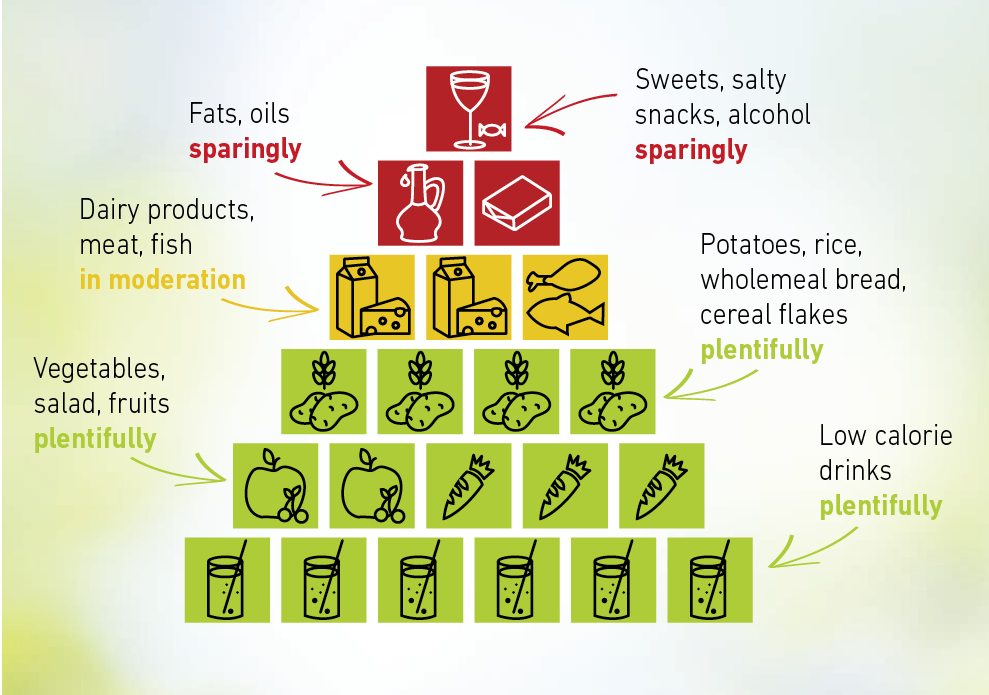Weight loss made easier
Losing weight in a healthy way and keeping it off permanently doesn’t have to be complicated. Here we’ve put together six tips for you to follow when losing weight. If you want to lose weight permanently, you should mainly concentrate on fat-conscious and calorie-reduced nutrition.
1. The three pillars of your “Weight loss made easier” program
1. Reduce calorie intake
• Consistently bind dietary fats and save many calories with 2 tablets of formoline L112 twice a day.
• Support weight loss with a conscious change of daily nutrition using the recommendations from the food pyramid.
2. Raise calorie consumption
Boost your metabolism and calorie consumption further with moderate exercise.
3. Feel good
Do something nice for yourself regularly to feel good about losing weight.
2. How healthy weight loss works
Above all else, healthy weight loss requires the permanent adaptation of your eating and living habits to the body’s energy needs. But changing entrenched eating habits takes a lot of perseverance, especially to start with.
With formoline L112 you don’t have to restrict the fat content in your diet as drastically as many diets call for.
For losing weight with formoline L112, we recommend a daily fat intake of 60 – 80 g.
Be patient with yourself and remember: Becoming overweight doesn’t come from one day to the next. To lose 1 kg of body fat you’ll need to save around 7,000 kcal.
Rapid weight loss can put a strain on the body and connective tissues, as it mostly comes from water loss. Healthy weight loss should therefore happen slowly. By saving 500 kcal a day, you can lose a maximum of 1 kg of body fat in 2 weeks.
3. The daily energy balance is crucial for your success
Successful weight reduction requires you to feed your body about 500 – 800 kcal a day less than it needs through diet and exercise. This negative energy balance causes your metabolism to revert to its fat reserves and this initiates weight loss.
Your daily energy intake should be no less than 1,400 kcal however, because an adequate supply of calories helps you avoid cravings.
Nutrition labels on many food packages tell you the calorie and fat content and provide good guidance for planning your nutrition. Tip: When cooking, weigh/measure all ingredients as accurately as possible. This helps you develop a feeling for healthy portion sizes and quantities.
4. What do you do if everything doesn't work out perfectly straight away?
To lose weight successfully, it’s important to stick with it, even if things don’t go to plan to start with. That’s normal and part of the process, because cherished habits can’t be changed overnight.
Your goal should be to slowly and gradually get used to a new, healthy lifestyle and raise your efforts from week to week. What really counts is continuous progress and your long-term weight loss.
When losing weight, enjoyment and zest for life mustn’t take a back seat. So when you choose your diet and exercise activities, make sure you feel well, your food tastes good and gives you pleasure – because only then will you enjoy sticking to it and not giving up!
5. Exercise, it doesn't have to be competitive sport
Any kind of physical activity does you good and burns calories. Even regular walking, say 30 min./day, can be helpful. Avoid taking the lift and instead regularly climbing stairs: This has been shown to strengthen the heart, circulation, respiration and metabolism.
A healthy lifestyle means consciously coping with stress, and relaxation is just as important as a balanced diet and sufficient physical exercise.
6. The food pyramid
The focus is on a healthy and varied diet with a balance of nutrient-rich and low-energy foods. The food pyramid shows how many portions of a food group should be consumed and also evaluates the nutritional value on the “traffic light” scale.
Low calorie drinks:
At least 6 servings (250 – 300 ml each) of beverages (mineral and tap water, unsweetened herbal and fruit tea, including one serving of vegetable and fruit juice) spread out over the day.
Vegetables, salad, fruits:
Daily 5 servings of fruits and vegetables, that’s about 400 g of vegetables and salad and 250 g of fruit (one serving = 1 handful or about 120 – 130 g).
Bread, cereals, pasta, rice, potatoes:
4 – 6 slices of bread per day or 3 – 4 slices of bread plus 50 – 60 g of cereal flakes and 200 – 250 g of potatoes or pasta (preferably from whole meal cereals) or 150 – 180 g of rice (unhusked).
Dairy products, meat, fish:
Daily 3 portions of milk and dairy products (such as milk and yogurt with 1.5% fat, skimmed curd cheese and cheese with 30 – 45% fat in dry matter) and 1 portion of meat, sausage, sea fish or egg.
Fats, oils:
Max. 2 servings (= 2 tablespoons, around 30 g) of high-quality fats and oils per day. The following are particularly valuable because they are rich in monounsaturated and polyunsaturated fatty acids and fat-soluble vitamins – olive, rapeseed, sunflower, corn and soybean oils. Reduce your consumption of animal fats, such as butter, lard and cream.
Sweets, salty snacks, alcohol:
You can consciously enjoy a piece of cake or a bar of chocolate occasionally.



